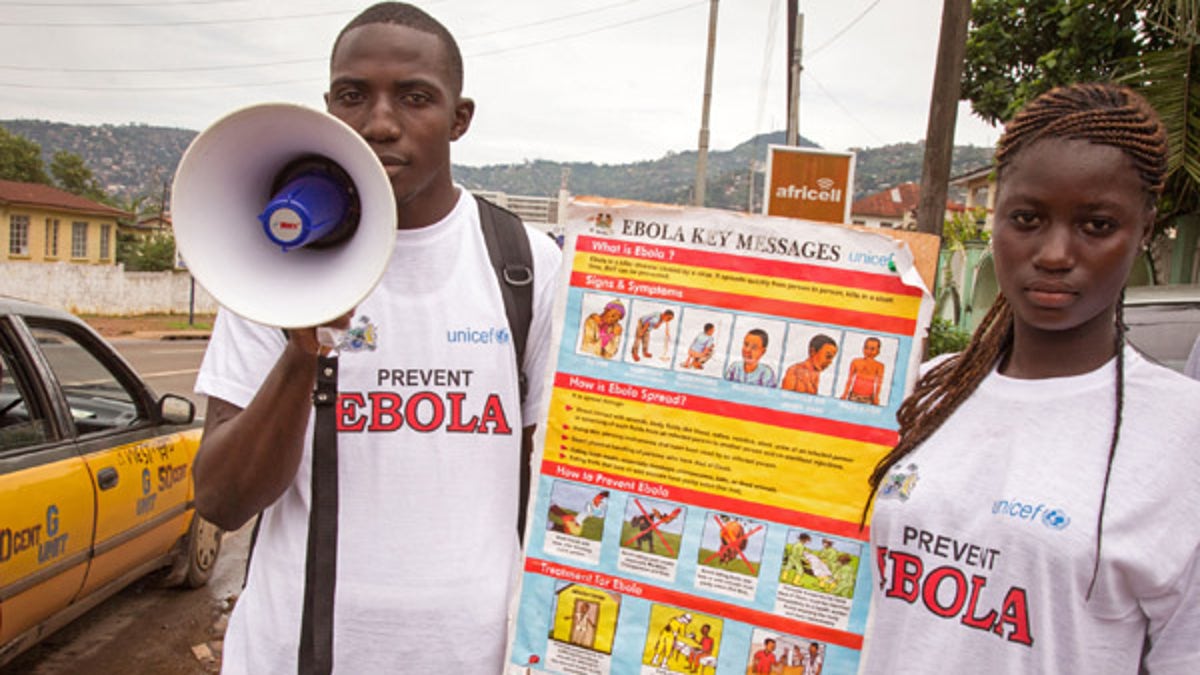
Aug. 6, 2014: A man and woman taking part in a Ebola prevention campaign holds a placard with an Ebola prevention information message in the city of Freetown, Sierra Leone. (AP)
Scientists have created a single treatment that may fight the two deadliest strains of the Ebola virus. The treatment is 100 percent effective in protecting laboratory mice against these strains.
The current Ebola medicine now being tested in humans, called ZMapp, is only aimed at the Zaire Ebola strain, which is responsible for the most recent and deadliest outbreak. But there are five known strains, including Sudan ebolavirus, which killed more than 200 people in 2000–2001, according to the Centers for Disease Control and Prevention.
Sudan ebolavirus and the Zaire strain, called Zaire ebolavirus, together have been responsible for about 95 percent of Ebola deaths since the virus was first identified in 1976, according to CDC data.
In the new report, scientists led by Jonathan Lai, an associate professor of biochemistry at Albert Einstein College of Medicine in New York, and John Dye, chief of viral immunology at the U.S. Army Medical Research Institute of Infectious Diseases in Frederick, Maryland, describe their new therapeutic approach as the first to be effective against the two main Ebola strains and perhaps the other strains, as well. [Where Did Ebola Come From?]
Their research appears today (Jan. 13) in the journal Scientific Reports.
The new medicine works by blocking the virus' ability to enter cells and reproduce. The Ebola virus is studded with molecules called glycoproteins, which look like hooks and help the virus invade cells. Lai's team engineered antibodies that stick to these glycoproteins and prevent the virus from infecting cells.
Each Ebola virus strain has distinct glycoproteins, and antibodies that target one strain and block the action of certain glycoproteins have been ineffective at blocking those of other strains.
Last year, Lai's team created the first engineered antibodies against Sudan ebolavirus. Now, in the new study, the group created "bispecific" antibodies that, for the first time, can block the activity of both Sudan ebolavirus and Zaire ebolavirus equally effectively.
Dye's team tested several of these bispecific antibodies in a biosafety level 4 (BSL-4) government laboratory, which is the only type of facility allowed to handle deadly viruses such as Ebola, Marburg and Lassa. In independent experiments, the researchers infected groups of mice with either Sudan ebolavirus or Zaire ebolavirus. Then, they gave the mice the various antibody therapies.
In all cases, most of the mice survived and cleared the Ebola virus infection. What's more, one particular bispecific antibody was 100 percent effective in protecting mice against both viruses.
"By creating engineered antibodies that have the ability to bind immunologically distinct viruses, you create a therapy that has the ability to respond to an outbreak without needing to know the actual causative pathogen," Dye told Live Science.
In other words, if there was an Ebola virus outbreak, and researchers didn't know which strain of ebolavirus was the culprit, they could still use this antibody as a treatment and feel confident that it would provide a potential benefit to sick people.
The next step is to test the experimental bispecific antibody in larger animals and ultimately humans.
"Our report is an encouraging first step, but we are still very far away from knowing if our antibodies could work in humans," Lai said. "Most antibody therapeutics that have been shown to be efficacious in nonhuman primates are cocktails of two or more antibodies. Our therapy at the moment is only a single antibody."
"It may be the case that a final broad ebolavirus therapeutic consists of a cocktail of multiple antibodies" with bispecific capabilities, Lai said. [The 9 Deadliest Viruses on Earth]
Lai noted that the new therapy is aimed at treating people who are already infected with Ebola, as opposed to a vaccine, which would be administered in advance to protect people against a possible Ebola infection. Nevertheless, Lai added, if his team's therapy is proven effective, it could likely be used prophylactically, to protect health workers or family members who come into contact with Ebola virus patients in lieu of a vaccine.
Dr. Jesse Goodman, a professor of medicine and infectious diseases at Georgetown University in Washington, D.C., who was not part of the new study, described the work as promising in its potential to offer an additional approach to the development of treatment for people with Ebola.
"The studies show that some engineered antibodies can protect lab mice treated one day after infection with either strain," Goodman said. "As the authors point out, however, showing benefit in mice does not always predict response in the nonhuman primate models more consistent with human disease, so those studies are needed."
"It will also be important to see if these antibodies are effective when administered more than one day after infection, which would be more representative of clinical use," he added.
Goodman also said it was worth noting that, in the current Ebola outbreak in West Africa, prompt diagnosis and state-of-the-art medical care, such as that received by evacuees to the U.S. and Europe, appeared to substantially reduce the death rate, which varied among centers in Africa, suggesting that supportive care can be further optimized in the field.
Still, nearly 40 percent of the more than 28,000 people infected in the current outbreak have died, further emphasizing the desirability of effective treatments, Goodman said.
- 10 Deadly Diseases That Hopped Across Species
- 6 Superbugs to Watch Out For
- 7 Devastating Infectious Diseases
Copyright 2016 LiveScience, a Purch company. All rights reserved. This material may not be published, broadcast, rewritten or redistributed.
